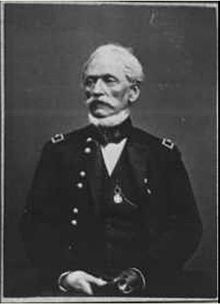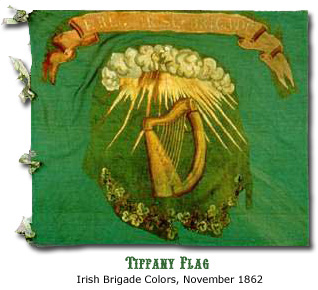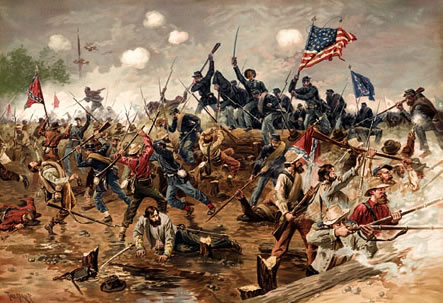Chapter One Hundred and Seven
Marching Through The Carolinas
Part IV
From “The North Carolina Campaign” by Thomas R. Yetters
Buffalo 2006
“Jackson initiated the battle at Statesville with the intent of repulsing Reynolds’ foray south of the Yadkin River. As Jackson’s vanguard, under Dick Ewell, came within sight of the town Stuart’s cavalry had formed west of the town on two hillocks, each with its own farmhouse: Watts and Edwards. Bartlett’s II Division of Lew Wallace’s Corps was pushing through the town in pursuit. Wallace spotted Ewell’s column and sought to form Duryee’s Division at the crossroads between the Mocksville Road (on which Reynolds’ advanced) and the Salisbury Road (Jackson). Duryee however was faced with by a problem, an inconvenience, that would plague many of Reynolds’ troops on the Mocksville Road – not only was it quite sunken (3ft or so) but large sections of it had been fenced by a local estate owner, Ezekiel Bell. Although the fencing would be broken up during the day it was a severe obstacle in the prompt deployment on Union troops from column, left facing, into line. The rebels faced no such problem on the more southern road as they advanced directly towards the Union column. Wallace had already directed Newton’s division to Bartlett’s right with the intention of securing the town and flanking Stuart…
Noticing the buildup of IV Corps (Wallace's) troops along the Mocksville Road, Jackson ordered Ewell's brigades into line for a swift assault on the tightly packed Union column. Aware that the ground was largely open between the two roads except for the slight eminence known as Signal Hill and a shallow creek, Jackson believed a swift attacked on the unwieldy Union column before it could deploy would undo any superiority in numbers they might have….
With Ewell’s four brigades advancing in line athwart the Salisbury Road, Jackson road back to direct A.P. Hill’s division to Ewell’s right to assault the next Union formation in column. Jackson was to repeat this with Winder. The three divisions, 12 brigades in all, would advance echelon against the main body of Reynolds’ column: Duryee’s Division of Wallace’s Corps, the three divisions Williams’ XII Corps and the leading divisions of Hancock’s I Corps (Stannard’s and Gibbon’s) – 16 tightly packed brigades…
Williams’ 3 divisions had particular difficulties getting from column into line. In the end both Geary and Greene would only deploy 2 brigades in front and 1 behind to cope with the narrow, obstructed frontage. Ruger’s division, which had but two brigades, deployed in line but with some regiments from each brigade in the second line…
The fourth division in Jackson’s line was that of Jubal Early. Having deployed his leading divisions in an attack echelon Jackson sought to strike the Union “flank” or rather what had been the head of the Union column. Jackson directed Early’s four brigades to Ewell’s left to join with Stuart’s dismounted troopers and redouble the assault on the town, now held by Generals Bartlett and Newton. With the body of the Union column engaged the only potential Union reserves near the head of the column were Custer’s tired horsemen…
Fighting on the southern edge of the town was intense. John B. Gordon’s brigade of Ewell’s division in particular would repeatedly penetrate Duryee’s line…
Jackson was quick to realize the importance of Signal Hill and directed his chief of artillery, such as it was, to deploy his batteries on the reverse slope which allowed the Confederate artillery to dominate much of the Union position…
A.P. Hill’s division with the support of the artillery would wreak havoc upon the divisions of George S. Greene and John White Geary. Further along the line Winder’s division has facing a more difficult proposition. He overlapped part of Thomas Ruger's Division, but more importantly General Hancock, with more time and more room, had maneuvered his two leading divisions out of the sunken road and into line of battle in the open field. General Stannard has also rushed out skirmishers who had occupied elements of the Bell family farm complex which would act as a strong point in the centre of Hancock’s line, albeit an isolated one…
Furthermore his divisions stood at an angle to Winder’s advance, and soon William E. Starke’s brigade came under a terrible flanking fire and Winder’s advance began to falter…
General Jackson had seen Hancock’s preparations from Signal Hill and had anticipated that Winder’s advance would come under sustained flanking fire. The fifth division in Jackson’s column was from Anderson’s I Corps. It was George Pickett’s 3 brigade Virginia Division. Pickett was ordered to march to Winder’s flank and support his attack. Pickett’s troops would have to march eastwards, passing behind Hill’s and Winder’s divisions, before angling northwards to support the attack…
General Winfield Hancock would earn great praise for the manner of his response to Pickett’s advance. Taking command of Doubleday’s I Corps he directed well beyond Gibbon’s left flank, into the fields, to meet Pickett’s advance before it would turn northwards. It was the smallest division in the Union army that day: the Black Hats brigade under Lysander Cutler and another brigade under Solomon Meredith. When Cutler remonstrated with General Hancock about his exposed position, Hancock replied “sometimes, general, the life of a corps commander simply does not count”…

Hancock reacts to Pickett's advance with one of his own
Despite a valiant attack by the brigades of Kemper, Garnett and Pegram, which overlapped Doubleday’s line and forced Meredith to refuse part of his line at right angles to prevent the line being flanked, Pickett’s advance was stopped and ultimately repulsed…
With the fighting on both flanks deadlocked, Jackson had one final division to deploy in what he hoped would be the decisive attack of the battle. Union reserves were at the rear of their column and distracted by the conflict between Pickett and Hancock. Jackson would direct his final division to the left – to join Ewell, Early and Stuart in an assault on Wallace’s IV Corps. If it was successful it could role up the Union line from the west back upon itself. The final division was commanded by John Bell Hood…”
From "Always The General - The Life of John Fulton Reynolds" by Jed Bradshaw
Penn State 1999
“Reynolds had quickly realized his mistake in allowing his force to become concentrated on the Mocksville Road, thus reducing its maneuverability. However Lew Wallace has formed a solid defensive line, in an L shape, well anchored at the corner in Statesville. Williams’ Corps was performing adequately in the centre, holding the line against a determined rebel attack. Reynolds also saw that Hancock was provided with sufficient artillery support when he countered Pickett. Although the rebels had the perfect position for artillery, on Signal Hill, and deployed it well, Reynolds had vastly more artillery which he deployed (in the absence of General Henry Hunt who remained with Kearny) effectively to counter both the rebel artillery with counter battery fire and in support of both flanks…
The attack by Hood’s Division threatened to unhinge Reynolds’ whole line. Wallace's forces, with Custer’s dismounted troopers on its right flank, had been finely balanced against the forces of Ewell and Early with Stuart’s troopers in support. Hood’s brigades, Wofford’s, Law’s, Kershaw’s and Barksdale’s burst through the hinge of Wallace’s line, splitting Newton’s division from that of Bartlett’s. Bartlett now had Ewell’s men to his front and Hood’s on his flank. His regiments were quickly being outflanked…

Hood personally leads the attack
Alpheus Williams would respond to Wallace’s plea for help by spending one of his brigades which, because of the narrow frontage, he had held in reserve. Zealous B. Tower would lead his brigade from the front on a beautiful white horse into a hail of metal. Tower’s brigade would slow Hood’s division but it could not stop it. Hood’s division would advance over a dreadfully wounded General Tower into the rear of Williams’ position…
General Reynolds had left General Humphreys’ V Corps (two divisions as the third had been assigned to hold Salem and Greensboro) behind at the crossing point over the Yadkin to ensure the rebels did not cut him off from Kearny. Reynolds therefore only had one corps in reserve – Sickles’ III Corps. Reynolds’ had moved Sickles from the rear of the column, east of Hancock, to a position north of the road in the rear of Hancock’s and Williams’ position. From this position Reynolds could use Sickles’ force to reinforce either flank or the centre. As the crisis emerged on the Union right at Statesville, Reynolds reluctantly turned to Dan Sickles to stem the rebel tide…
Dan Sickles would become one of the heroes of the battle
Gersham Mott led off with the brigades, of what Sickles laughingly called “Jesus, Mary and the two Josephs” Joseph Carr and Joseph Revere. Charles T. Campbell’s brigade was in reserve. Further north and east Amiel Whipples shook out his division in a similar formation, two brigades in front – Gilman Marston’s and Stephen G. Champlin’s, with one in reserve – Abram S. Piatt. In the rear came Dan Sickles with his third division in line of battle, with an ill David Birney barely able to keep his seat. The brigades of Charles K. Graham (under Colonel Henry J. Madill as Graham had been injured at Thomasville), John H.H. Ward and the bloodied force of Thomas Egan (under Colonel Byron R. Pierce leading those elements not captured at Thomasville. The brigade was barely 600 men at Statesville)…
The nine brigades of Sickles’ III Corps, though well under strength and recently bloodied at Thomasville, smashed into Hood’s advance and sent the rebels reeling back to the town. Rallying his own division, as well as elements of Early’s and Ewell’s commands Hood made a defiant stand at the crossroads in Statesville. He meant to stop and throw back Sickles’ troops. But Hood was not the only general rallying his troops. General Reynolds ensured General Wallace reformed his formations in Sickles rear and that General Greene’s division of Williams' corps was reformed as well…
General Reynolds kept a close watch on Sickles’ advance but he need not have feared. This was the kind of engagement where Sickles’ aggressiveness could do nothing advance the course of the battle in the Union’s favor…
With Whipples’ division overlapping the rebel line and swinging south it was the rebel line that became unhinged. Reynolds ordered his entire line to advance and attack. Union numbers and Reynolds’ leadership had finally begun to tell…”
From “The Blue Eyed Prophet of War” by Robert Lee Thomas
Carlotta Press 1906
“Did General Jackson know that the moment had passed? That the last great attack by the Army of Northern Virginia had been made? Perhaps he did as he ordered his troops to fall back. He was disgusted. General Pickett had failed to press the Union left. General Winder had not shown the alacrity needed. The men had fought. How the men had fought but Jackson felt that too many of the army’s generals simply could not follow orders…”
From “The North Carolina Campaign” by Thomas R. Yetters
Buffalo 2006
“Reynolds did not initially allow General Jackson to break contact. Generals Hancock and Sickles were quick to ensure their troops pressed the retreating rebels. Even the cavalry, under Custer, exhausted and light on ammunition pursued the rebel troops. In a dramatic action that would keep the arm blanche alive in the US Army for another 50 years element’s of Custer’s division charged a rebel regiment. A North Carolina regiment of Branch’s brigade (Early’s division) formed square in the presence of cavalry. An archaic manouver but often an effective one in the absence of enemy artillery. It was standard military doctrine that cavalry could not break infantry in square. No one it seems had managed to teach George Armstrong Custer that. With Russell A. Alger and the Michigan Brigade at his rear they charged the North Carolinians with sword, with pistol, and with carbine. Against doctrine but perhaps not the odds (the North Carolinians were likely out of ammunition, tired and unfed) the square broke and a legend was cemented…”
Last edited:
























































